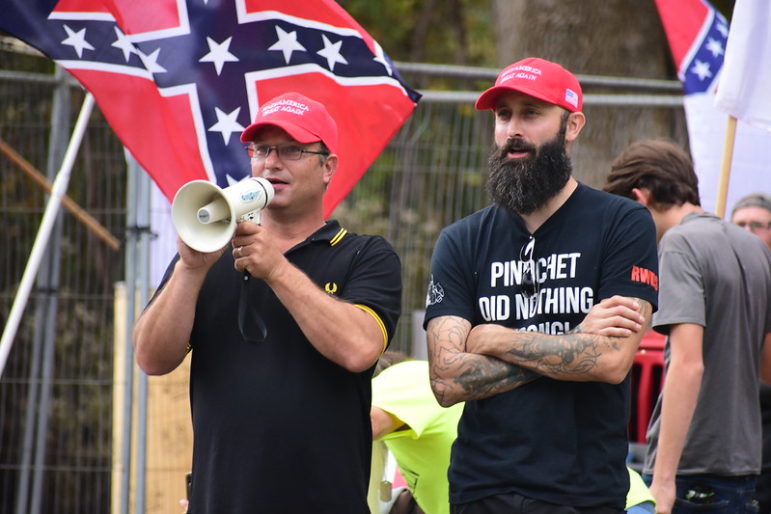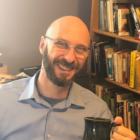
Proud Boys members speak in North Carolina. Photo: Anthony Crider. Image: Flickr
The threat of voter intimidation and disinformation from far-right groups — openly encouraged by one campaign — emerged this past week as the darkest shadow hanging over the US elections in 2020.
In week three of GIJN’s project to arm reporters with tools to tackle the toughest US election stories, #gijnElectionWatchdog focuses on these threats, and includes three little-known election “killer apps”: the first, to zero in on who’s coordinating the disinformation; the second, to assess foreign election interference; and a third, to dig into far right groups bent on intimidating voters. It also offers a simple dataset for arguably the most important work you can do in this election: informing audiences in 20 states that their voter registration deadlines are this week.
Here are some of the highlights from the project’s Twitter feed this week:
- Tracking far right groups: Buzzfeed’s superb misinformation reporter Jane Lytvynenko tells GIJN that — while right-wing conspiracy groups like QAnon can still be tracked on Facebook using CrowdTangle — searches for militia groups should start on platforms like Telegram, or conservative social media networks like Parler and Gab. She suggests trying keyword searches in tgstat to hunt for militia-type Telegram channels. Don’t assume fringe group members don’t want to talk, as many like the attention — but don’t use your personal phone or account when reaching out. See her five tips to investigative militia groups and conspiracy theorists. Read the research on these groups by Data & Society and on Graphika, and check out Jane’s favorite sleuthing tricks key. For more background on the far-right and militia groups, with a list by state and county, check the Southern Poverty Law Center.

Screenshot: CooRnet
- Exposing Disinformation Superspreaders: How can you distinguish between coordinated social media election disinformation and innocent, popular sharing? At the 2020 Investigative Reporters & Editors Conference, Zarine Kharazian, assistant editor at DFRLab, revealed how a program developed by researchers at Italy’s University of Urbino can detect coordination from misinformation links that reporters track on CrowdTangle. CooRnet — a tool within the R programming language — uses algorithms to pick up suspicious sharing patterns. It packs even more power when combined with the Gephi open-source visualization platform.
- Calculating Foreign Interference: Here’s one tool US reporters were definitely missing in 2016: The Atlantic Council’s Digital Forensic Research lab (DFRLab) has released the Foreign Interference Attribution Tracker (FIAT) — which is both an open source database of claims of foreign interference in the US 2020 election, and a tool that provides an assessment score for the credibility and impact of each claim.

Screenshot: This example from East Baton Rouge, LA, from CPI, shows how the relocation of a polling station (“N”) away from registered Black voters (shown in red) skews turnout against minority voters.
- Digging into polling location dirty tricks: In the first of three GIJN election webinars, Pulitzer-winning reporter David Cay Johnston said voter suppression by targeted polling station closures was one of the hottest subjects for investigative reporters — and that comparing 2020 locations to past polling addresses was the place to start. The Center for Public Integrity and Stateline just released a searchable dataset that allows reporters to do precisely that for 30 states. Based on a deep analysis of 1200 public records, the tool can search polling place data from 2012 – 2018, and includes a detailed use-case explainer.
- The most important (and easiest) story you can report: Starting October 3 in South Carolina, followed by states like Florida and Texas on October 5, early voter registration deadlines strike 20 states in the coming week, thanks mostly to laws designed to reduce voter turnout to favor one party. Journalists on every beat in these states should alert their audiences to these deadlines, and on how to register. Political scientist and author Thomas E. Patterson provides the dates, and sets out the stakes, in this piece.
 Rowan Philp is a reporter for GIJN. He was formerly chief reporter for South Africa’s Sunday Times. As a foreign correspondent, he has reported on news, politics, corruption, and conflict from more than two dozen countries around the world.
Rowan Philp is a reporter for GIJN. He was formerly chief reporter for South Africa’s Sunday Times. As a foreign correspondent, he has reported on news, politics, corruption, and conflict from more than two dozen countries around the world.
